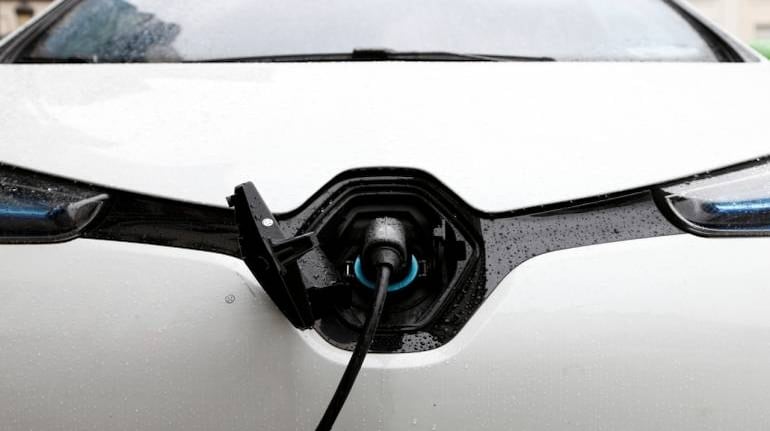
The government has accepted the Europe-based combined charging system (CCS) for electric vehicles, ending the ambiguity over charging protocol, sources told Moneycontrol. Also, the government is betting on two/three wheelers to spearhead e-mobility in India.
“In a meeting held last week, all the stakeholders agreed that CCS-based charging will be the best suitable charging module for the country,” sources said.
CCS based chargers combine different charging methods – Alternate Current (AC) and Direct Current (DC) -- into a single connector.
Major auto-companies like Volkswagen, Hyundai, Ford Motors, Renault, BMW, Chevrolet, Audi, Jeep and Fiat follow the European standard in India while home-grown majors like Tata Motors and Mahindra & Mahindra prefer Bharat EV standard due to its easy compatibility with European standard.
Interestingly, India’s largest car manufacturer, Maruti Suzuki, prefers Japan-based CHAdeMO system developed by its parent Suzuki Motor Corp. and Toyota Motor Corp.
CCS was selected from a host of charging protocols available including CHAdeMO (Japanese), GB/T (Chinese) and Tesla Superpower.
Indecision regarding specific protocol was one of the reasons for sluggish adoption of electric vehicles in India. With no charging stations available at close quarters, public acceptance for the cleaner-mobility solution was minimal.
Also read: Allocation under FAME-II will help decide charging infra roadmap, says Power secy
Ajay Bhalla, secretary, Ministry of Power had told Moneycontrol that the ministry was awaiting suggestions from Department of Science and Technology to finalise a standard protocol and that the roadmap for stations will depend on the amount given to the department under FAME scheme.
“The executive finance committee has done their studies and the scheme will be sent to the cabinet unless that is done, we cannot do anything... That is not our department,” he had said.
Sources, however, said that announcement regarding the same may take some time as second phase of government’s subsidy scheme, FAME India, for e-mobility has been deferred for another six months.
“There will not be any specific policy-like announcement… Government has decided to take things forward as they are with CCS based charging,” said a person privy to the development.
Consequently, all the companies that are planning to set-up charging stations in India will have to follow the European standards.
Currently, various state-run companies are planning to set up charging stations in the country. These include, Hindustan Petroleum Corporation Ltd (HPCL) together with Tata Power, National Thermal Power Corporation (NTPC), Gail India, Indian Oil Corporation (IOC) and Energy Efficiency Services Ltd (EESL).
Another person said that petroleum firms like IOC and HPCL have enough space to facilitate charging infrastructure in the country.
“They can set up these stations at their conventional fuel pumps… They are big enough to support entire city,” he said.
Moneycontrol first reported on September 24, that Department of Heavy Industries (DHI) could notify extension of Faster Adoption and Manufacturing of (Hybrid and) Electric (FAME) India scheme’s first phase till March 31, 2018. The official notification came on September 27.
“It has been decided that the period of the FAME-India scheme be further extended for a further period of six months up to March 31, 2019 or till notification of FAME-II, whichever is earlier,” the ministry said.
According to sources, FAME-II could be deferred beyond April due to Lok Sabha election 2019.
Back to basics: Centre to focus on two/three wheelers
According to people in the know, government has shifted its focus towards two and three wheelers to push electric mobility in India.
“Close to 54,800 two wheelers were sold in India last year… E-rickshaws were 0.8 million (eight lakh)… Both these segments don’t need extensive charging infrastructure,” they said.
According to sources, Centre could promote battery swapping for auto-rickshaws due to their standard model.
“Battery swapping is a fruitful model for three wheelers. As they have to move long distances under work obligations, it can easily swap batteries,” they said. “Thus, it is very much doable for three wheelers”.
Sources said that government is veering towards promotion of “highly penetrated” vehicles.
“The focus was on buses and public transport, but the reports (released by NITI Aayog at various time intervals) reveal that their focus has shifted from buses to three wheeler as that’s where the penetration will happen,” they added.
According to ‘India Leaps Ahead’, a report released by National Institution for Transforming India (NITI) Aayog, Centre should focus on creating “standardised, smart, swappable batteries for 2- and 3-wheelers to electrify these important vehicle segments as quickly as possible”.
Their recent report, 'Moving Forward Together: Enabling shared mobility in India' on shared mobility also underscored promotion of “high occupancy” vehicles.
“For promoting high occupancy vehicles, contract carriage permit systems may need to be reviewed in order to allow more flexibility to state governments to support different types of shared mobility models. Some of the recent examples like Tamil Nadu Motor Vehicle Rules recognizing the usage of auto-rickshaws with contract carriage permits for shared mobility are regulatory initiatives that could encourage shared mobility models,” it noted.
Currently, there are close to 2,10,000 electric two-wheelers. Out of these, more than 98 percent are low powered and low speed variants (maximum power not exceeding 250 Watts and maximum speed not exceeding 25 kilometers per hour).
Sources said that due to supply constraint, that is only “handful” auto-makers operating in India, it is difficult to promote electric mobility through cars.
“It’s easy to say that buses and cars will be supplied, but in reality there hardly is any suppliers for cars. There is no supply side for cars in India. It is only for two wheelers that one or two makers are holding the entire sector,” they said.
Discover the latest business news, Sensex, and Nifty updates. Obtain Personal Finance insights, tax queries, and expert opinions on Moneycontrol or download the Moneycontrol App to stay updated!